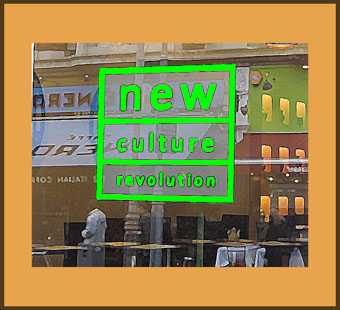March 2006 Archives
Natalie Portman, who is currently starring in the movie V for Vendetta, was recently the host of Saturday Night Live. The following rap video was first aired during that appearance. SNL has had some recent success with these digital shorts since they employed Andy Samberg. Samberg had made a few videos as part of a group called The Lonely Island. I believe SNL found him by virtue of a pilot they had pitched to Fox. His digital short with Chris Parnell, Lazy Sunday - The Chronicles of Narnia Rap, was an instant hit and the internet was immediately deluged by the video. Within a short period of time, NBC forced You Tube to pull the video but it can still be viewed here. Samberg appears in the Portman rap as well.
I've been a huge Natalie Portman fan since she appeared with Zack Braff of Scrubs in his movie Garden State. If you haven't seen the movie, I highly recommend it. The rap video is a big departure from the character she played in Garden State but she seemingly pulls it off with ease.
Daniel DiRito | March 31, 2006 | 7:04 PM |
link
| Comments (1)


The nomination of Samuel Alito to the Supreme Court, as well as any subsequent appointments creates a dilemma not recently witnessed in the course of American judicial history. The heightened level of consequence is well framed by the issue of abortion and the case of Roe v. Wade. Over the years, decisions made by the Supreme Court have generally granted additional rights and a generally more flexible interpretation of the Constitution. Examples include the repeal of prohibition, voting rights for women and blacks, integration, and affirmative action. Proponents of such decisions argue that the Constitution, albeit a document of arguably unequaled forethought, could not be expected to address all the issues that might occur over the course of time. They also argue that the court must often act to insure the rights of minorities in the absence of support by the majority.
Today, with the preference by many to appoint jurists with a strict constructionist view, we have entered a period one could characterize as a reversal of direction…a move towards limiting the expansion of the Constitution and its interpretation to primarily stop or undo the expansion of secular social issues. This confluence of issues is troubling and has significant ramifications. Complicating this crescendo is the fact that the basis of the arguments being made by the opposing sides have also, to a degree reversed. Many former states rights combatants have become more centralized federal government proponents and visa versa…although this is often applied issue by issue rather than as a fundamental theory of government. Examples that demonstrate this reversal include the issues of abortion and gay marriage. Opponents of abortion prefer a states rights interpretation while at the same time support an amendment to the United States Constitution to ban gay marriage. The opposite preferences are found amongst those that support abortion rights and gay marriage.
Both sides increasingly see the judiciary system as a political tool to be manipulated in order to obtain a favorable outcome. The calculations are often made issue by issue after evaluating the potential court systems at play. Simultaneously, the feasibility of the states rights theory diminishes each day as the relevance of individual state borders are overwhelmed by a rapidly expanding interstate connectivity. Specifically, with Roe v. Wade, opponents argue the ruling should be overturned since it was wrongly wrestled from the appropriate legislative grip of a state by state resolution whereby the people, through majority vote, elect legislative bodies to then pass laws that reflect the will of the majority. This approach, although feasible and consistent with much of our historical process, runs counter to the growing conflation of the states.
Once this background noise is acknowledged, the debate must shift to an analysis that is driven by the considerations of outcome. Legal and constitutional principles notwithstanding, the results of a state by state definition and determination of abortion rights and gay marriage become the necessary focus. Ultimately, by whom and how would the mechanics be applied and administered? Would a woman impregnated in Utah, where abortion is illegal, who travels to California, where abortion is legal, be charged upon returning to Utah with a crime if she had an abortion? Would a doctor with a practice in multiple states be charged with a crime in a state where abortion is illegal if he in fact performed abortions in another state where abortion is legal? Would either of the partners in a gay couple from Massachusetts traveling through Arkansas be allowed access to their partner if they were in an automobile accident and one became incapacitated and unable to make medical decisions? What happens when a gay couple in Vermont, where one is HIV positive, and the health insurance he has is by virtue of the other partner’s employment, must move to another state where such benefits have been prohibited?
Granted many of these details have or can be sorted out and legislated as needed…but if one clearly listens to the goals of those on either side of the issues…this patchwork resolution wouldn’t be satisfactory. To presume that anti-abortion activists living in a state where abortion is illegal would be content to disregard the abortions happening in an adjacent state is absurd. The same is true for abortion proponents. To presume that gays will conclude that equal rights provided by some states are sufficient is similarly absurd. What this analysis seeks to illuminate is that the legality of abortion, despite being considered nationwide settled law by its proponents, will remain an unsettled issue by both sides regardless of the origin of that legality or illegality (Roe v. Wade or state by state). The same argument holds true for gay marriage. To assume the foment wanes once each state is given authority or once a constitutional amendment is passed is antithetical to the issues. If an anti-abortion activist succeeds in his or her state, it doesn’t follow that their belief in an obligation to make abortion illegal everywhere else subsides. Were that the case the longstanding argument that says if you oppose abortion, don’t have one would suffice.
The bottom line is that these issues will not remain confined to state boundaries and those who refuse to acknowledge this are either in denial or merely looking to change the dynamic in hopes of a different final outcome. What this means when returning to the issue of Supreme Court appointments is that while great focus is placed on these appointments, a far more important consideration is not discussed. While the two sides bask in the hope or presumption of victory, the consequences of that victory remain unexplored and absolutely unarticulated. The shimmer of noble nostalgia generated by a return to states rights that is envisioned by many or the vindication and upholding of a judicially settled policy imagined by the other side will likely result in nothing more than heightened conflict and controversy. Hence, the oft protected ideological leanings of appointees is all absorbing but dangerously absent any forthcoming discussion of the possible real world outcomes of their potential decisions. Victory will not be won with the next appointment to the Supreme Court. History tells us abortions and gay couplings will persist despite adjudications. Its time we accept this reality and begin the actual process of an honest debate.
Little thought seems to be given to the rationale behind the separation of church and state that was dictated by the founding fathers. Given sufficient review, one could reasonably conclude that the well crafted governmental model was in fact the result of the debate I’m currently proposing. We can reopen the debate but as long as there are citizens unwilling to acknowledge the lessons inherent in the experiences of our past, we will flail in conflicts that cannot be resolved through judicial manipulation. I would argue that the very type of conflicts identified herein precipitated this countries origin and guided the creation of our constitutional foundation. Religious views and values are legitimate but given the absolute nature of such beliefs, no one government system can assuage all of the belief systems. Further blurring the lines between religion and government cannot succeed. This may mean that the only feasiblee common ground will require both sides to accept the original lines of separation that were used by our forefathers to determine individual freedoms…and likely nothing more or nothing less. For now it would be best if both sides acknowledged this reality.
Daniel DiRito | March 5, 2006 | 11:59 AM |
link


"But life is short and truth works far and lives long: let us speak truth."
...Arthur Schopenhauer (02/22/1788 - 09/21/1860)
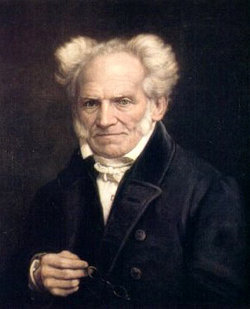
Arthur Schopenhauer was an influential 19th century philosopher with a generally pessimistic leaning. Often accused of being arrogant and aloof, he saw life as essentially evil and futile but was also hopeful that art (aesthetics) and a sympathy for others could offer escape from pain and suffering. He is seen by many as misogynistic although he also said that "women are decidedly more sober in their judgment than (men) are" as well as more sympathetic. He also was one of the first to write about homosexuality as a natural occurence. I find the above quotation timeless and meaningful. I also think its good commentary on the search for truth...we're all searching for it and we often think we speak it...but in fact we often don't. It simply points out that one can never abandon the search for more truth.
UPDATE:
Unbeknownst to me, Schopenhauer was referenced in the recent movie Wedding Crashers. A friend of mine sent me this link. Obviously, the movie is using Schopenhauer's philosophies for comic purposes but if you are interested in some serious discussion of his philosophies, check out the same site here and here for a couple of informative podcasts.
Daniel DiRito | March 5, 2006 | 8:43 AM |
link
| Comments (0)


"Global Mobile" is a recurring posting here at Thought Theater. The objective of the category "Traveliscious" is to provide information about places around the world with a focus on sites of significance and substance. I've never been that fond of high traffic tourist attractions although there are some locations worth seeing regardless of the numerous rubber-necking tourists you will be forced to endure. Readers are also encouraged to use this category to introduce remote, yet noteworthy destinations along with their own memorable recollections.
Placa de Sant Felip - Barcelona, Spain
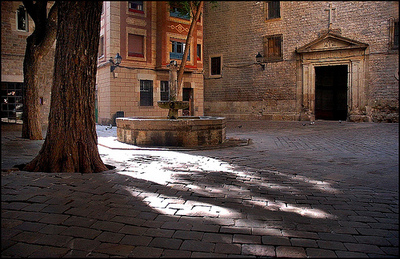
My first entry is about Placa de Sant Felip in Barcelona, Spain. For me, it's truly one of the world’s unique jewels. It’s a place with overwhelming human spirit, substance, and significance. If you ever travel to Barcelona, it’s an absolute must.
Barcelona is a city teeming with culture where the people have a vibrant and infectious pride and passion for their colorful history. There is an unyielding energy from sunrise to sunset. The streets are awash with people all hours of the day, especially at Las Ramblas, a favorite boulevard with a broad pedestrian walking island running the center of the street. As a major social area of the city, you can buy virtually anything you want including food, flowers, birds, and bunnies.
The Spanish culture is unique. Midday siestas see many of the businesses close for around two to two and a half hours while many restaurants remain open to accommodate the lunch crowd. Breakfast is virtually a nonevent…people seem to grab something on the way to work and the choices are limited to baked goods and more typically a traditional snack that includes a slice of cured ham on bread. After siesta, the businesses stay opened till around seven in the evening. Shortly thereafter, the city transforms into a social and cultural wonder as people walk the boulevard with wives and mothers on the arms of husbands and daughters. By ten at night the restaurants begin to fill for dinner…seemingly late by American standards but the norm in Barcelona. Following dinner, with typical Spanish charm and chivalry, husbands buy flowers for wives or for an elder parent as they make the stroll home.
While visiting the city I met a man named Javier who graciously volunteered to show me the sights. We saw many things including some of Gaudi’s architectural gems, the Picasso Museum, and my favorite, the Gothic district. This is one of the older areas of Barcelona and it’s a maze of attached buildings with most streets only suitable for foot traffic. As the day came to a close around dusk, Javier led me to a place called Placa de Sant Felip Neri, a charming square tucked away down one of the winding walkways. The lighting at the time gave the square a mystical air that made the moment almost breathtaking. Javier, who spoke only the slightest amount of English, explained to me, mostly in Spanish, that it was a site where, during the Spanish Civil War, people were lined up in front of a small church and executed. The front of the church is covered in pockmarks and divots from the splash of bullets. It was stark and real and amazing all at the same time and I couldn’t help but think about the people who met an untimely end at such a beautiful and tranquil oasis. Much to my disappointment I had forgotten my camera that morning but I vowed to myself that I would return to take pictures
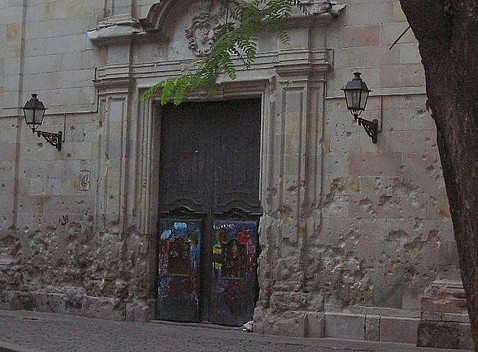
This is the wall of the church and the entry doors.
The next day I stopped at the front desk of my hotel hoping to get directions or a map to guide me back to the plaza. In broken Spanish I explained what I was looking to find and the clerk indicated he knew the place but it would be too complicated to try to give me directions. He suggested a map but I didn’t have the actual name of the plaza and he couldn’t recall the name either. Determined to find it, I set out alone for what turned out to be an amazing and remarkable day. I scoured the Gothic for hours trying to retrace the path from the day before but I could't locate the plaza. As it got to be late afternoon, I accepted I wasn’t going to find it so I decided I would go back to the hotel and ask again for help to search once more the following day. Resolved, I began walking back towards the hotel. I turned down a street just as a musical trio (these groups are found all over the city) was finishing a song. As I approached them, they began to play Amazing Grace…I turned at the corner where they were singing and there stood the plaza I had searched for all day. Fully overcome, I literally shed tears on the spot. Something about that moment felt so true and so right…there was something sacred about where I had arrived and I was overwhelmed by the thought of the fate that befell so many people. I wanted to know their stories and wondered what happened to their friends and families. In my mind, I had the thought that everyone in the world needed to see this place…to understand just how precious life really is…and to realize how wrong it is to take that away.
Since my return, I did some research on Placa de Sant Felip. What I found was even more compelling. There is an old cemetery that lies underneath the site. In addition to the executions, a bomb also killed thirty school children in the plaza during the Spanish Civil War. Lastly, Antoni Gaudi was run over and killed while on his way to the plaza in 1928. In one of the articles I read about Placa de Sant Felip, I was struck by this statement “The squares ghosts are peaceful ones, however, and in the early evening light of a summer’s day there can be no more beautiful spot in the city". I thoroughly agree and I couldn’t have said it any better.
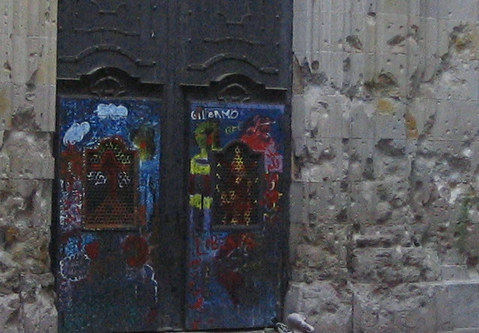
If you look at the divots and pitting to the right of the doors you can
see the pattern of a face created by the deluge of bullets.
Daniel DiRito | March 4, 2006 | 4:30 PM |
link
| Comments (0)


![]()
![]()




